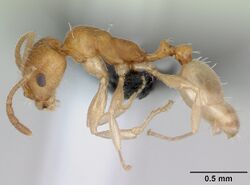Biology:Royidris
| Royidris | |
|---|---|

| |
| Royidris robertsoni worker | |
| Scientific classification | |
| Domain: | Eukaryota |
| Kingdom: | Animalia |
| Phylum: | Arthropoda |
| Class: | Insecta |
| Order: | Hymenoptera |
| Family: | Formicidae |
| Subfamily: | Myrmicinae |
| Tribe: | Crematogastrini |
| Genus: | Royidris Bolton & Fisher, 2014 |
| Type species | |
| Monomorium robertsoni Heterick, 2006
| |
| Diversity[1] | |
| 15 species | |
Royidris is a Madagascar genus of ants in the subfamily Myrmicinae. Described in 2014, the genus contains 15 species endemic to Madagascar .[2]
Description
Queens are known for R. admixta, R. diminuta, R. notorthotenes, R. peregrina, and R. shuckardi, plus two unassociated forms. Alate when virgin, considerably larger than the worker. Males are known only for R. notorthotenes and R. peregrina. About the same size as the worker or slightly smaller, much smaller than the queen.[2]
Taxonomy
The species included in this genus exhibit a habitus that is convergent on some groups of Monomorium. In his study of the Afrotropical members of that genus Bolton (1987) noted two indeterminate Madagascan species which had a high palp formula (5,3), the highest attributed to Monomorium, but did no further analysis of these odd species because the focus of the survey was the extensive Afrotropical fauna. Heterick (2006), in his revision of the Malagasy species of Monomorium, recognised the peculiarity of the high palp formula and utilised it, together with some other characters, to define his M. shuckardi group, all members of which are now transferred to Royidris. No unambiguous apomorphy can be stated for Royidris, and in fact its habitus is similar to that commonly seen in Monomorium.[2]
Species
|
|
References
- ↑ Bolton, B. (2014). "Royidris". AntCat. http://antcat.org/catalog/461740.
- ↑ 2.0 2.1 2.2 2.3 Bolton, Barry; Fisher, Brian L. (2014), "The Madagascan endemic myrmicine ants related to Eutetramorium (Hymenoptera: Formicidae): taxonomy of the genera Eutetramorium Emery, Malagidris nom. n., Myrmisaraka gen. n., Royidris gen. n., and Vitsika gen. n.", Zootaxa 3791 (1): 1–99, doi:10.11646/zootaxa.3791.1.1, PMID 24869996, https://zenodo.org/record/11433
- Bolton, B (1987). "A review of the Solenopsis genus-group and revision of Afrotropical Monomorium Mayr". Bulletin of the British Museum (Natural History) Entomology 54: 263–452.
- Heterick, B.E. (2006). "A revision of the Malagasy ants belonging to genus Monomorium Mayr, 1855". Proceedings of the California Academy of Sciences 57: 69–202.
 This article incorporates text from a scholarly publication published under a copyright license that allows anyone to reuse, revise, remix and redistribute the materials in any form for any purpose: Bolton, Barry; Fisher, Brian L. (2014), "The Madagascan endemic myrmicine ants related to Eutetramorium (Hymenoptera: Formicidae): taxonomy of the genera Eutetramorium Emery, Malagidris nom. n., Myrmisaraka gen. n., Royidris gen. n., and Vitsika gen. n.", Zootaxa 3791 (1): 1–99, doi:10.11646/zootaxa.3791.1.1, PMID 24869996, https://zenodo.org/record/11433 Please check the source for the exact licensing terms.
This article incorporates text from a scholarly publication published under a copyright license that allows anyone to reuse, revise, remix and redistribute the materials in any form for any purpose: Bolton, Barry; Fisher, Brian L. (2014), "The Madagascan endemic myrmicine ants related to Eutetramorium (Hymenoptera: Formicidae): taxonomy of the genera Eutetramorium Emery, Malagidris nom. n., Myrmisaraka gen. n., Royidris gen. n., and Vitsika gen. n.", Zootaxa 3791 (1): 1–99, doi:10.11646/zootaxa.3791.1.1, PMID 24869996, https://zenodo.org/record/11433 Please check the source for the exact licensing terms.
Wikidata ☰ Q17107781 entry
 |

